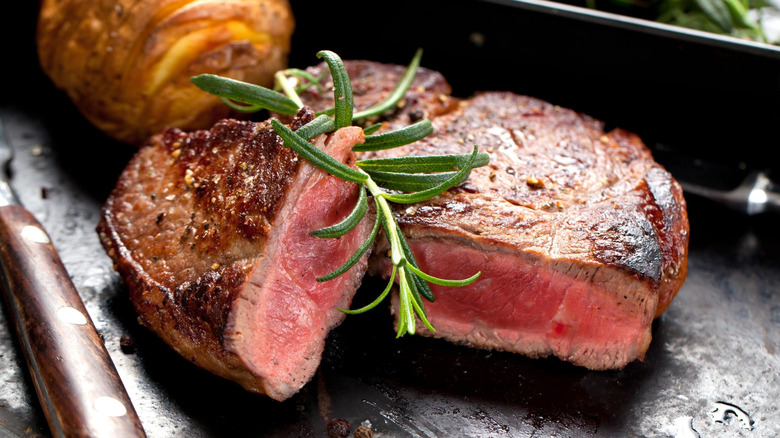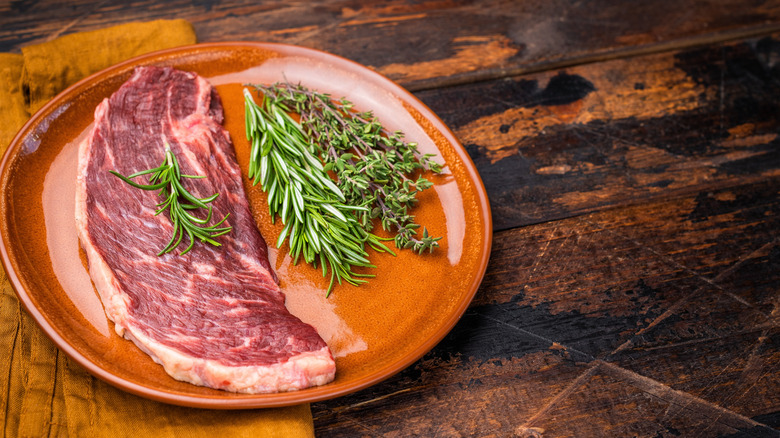Cooking New York Strip Vs Sirloin: The Difference Is In This Simple Rule
Everyone knows what steak is, but ask someone their favorite kind, and you'll have a variety of different answers. That's because "steak" is an umbrella term that covers a wide range of specialized dishes. The breed of the cow alone can set the stage for what you're going to eat, with prized varieties like wagyu and Angus carrying their own distinct textures and flavors.
Beyond breed, the cut of meat plays an even bigger role in shaping your steak experience, with each one having its own texture, fat content, and connective tissue, all of which shape its specific cooking requirements. A ribeye is a completely different cut from a filet, and a New York strip will never taste close to a flank or skirt. That's why understanding the nuances of each steak is so important for professional and home chefs alike if they want to get the most out of their steaks. Just look at two of the most popular cuts of steak, New York strip and sirloin, which couldn't be more different in their characters and, therefore, cooking styles.
To find out more, Food Republic consulted David "Chef Fig" Figueroa, the president, CCO, and cofounder of Melinda's Foods and a professional chef, certified grillmaster, and cooking expert. His simple steak cooking trick? "If the cut has marbling, rely on dry heat and shorter cook times. If it's lean, give it a marinade or tenderizer and watch your doneness closely."
What is a New York strip?
The New York strip is a high-end steak and a fixture on the menus of premium steakhouses. As David Figueroa explained, this cut is "dense, fine-grained, and well-marbled, with a rich, beef-forward flavor and a firmer bite." Its tenderness and refined texture are due to its origin in the short loin, a section of the cow that sits just behind the ribs and in front of the sirloin. This muscle isn't used for heavy lifting, so the meat stays naturally tender with a finer grain compared to working cuts like brisket or chuck.
Where the strip shines is in its balance of fat and lean muscle. It contains more marbling — streaks of intramuscular fat — than a sirloin, but less than ultra-rich and fatty cuts like a ribeye, which places it in the a sweet spot of being rich enough to deliver a juicy, beefy flavor while not being too heavy.
Due its rich marbling, Figueroa advised, "The strip is at its best with high-heat, quick cooking, whether grilled over hardwood charcoal or seared in a cast iron skillet to lock in that marbling. Keep it medium-rare to medium so the fat renders and the steak stays juicy." When rendered gently, the fat will baste the steak from within and enhance its flavor profile. Be careful not to overcook your New York strip, as this will cause the fat to render out completely and the fine muscle fibers to tighten, which, Figueroa warned, "turns a beautifully marbled steak into something tough and dry."
What is a sirloin?
Compared to a New York strip, sirloin is a more accessible, more affordable cut of steak. According to David Figueroa, sirloin is "leaner and less marbled, with a slightly more rugged texture and a lighter beef flavor. ... but it won't give you the same melt-in-your-mouth experience as a strip."
The reason for sirloin's lower price tag and leaner texture is that the sirloin comes from the back of the cow, where the muscles work harder, resulting in less marbling and a firmer bite due to longer muscle fibers and denser connective tissue. Figueroa went on to explain, "The exception is the bottom sirloin flap, also known as bavette or tesajo. It is beautifully marbled, full of flavor, and absolutely steakhouse quality." This gives it a tenderness and richness that sets it apart from other sirloin cuts, and it's a good value-for-money option.
Due to its denser, tougher texture, the best way to cook sirloin is to "marinate it to boost tenderness and flavor, then grill or pan-sear it quickly, slicing against the grain for best results," Figueroa told us. Marinades and slicing against the grain both work to make the meat more tender. Alongside steak marinades being a simple way to boost your steak's flavor, long marinades break down muscle fibers and connective tissue, while slicing against the grains — aka muscle fibers — shortens them. One reliable pantry ingredient for tenderizing tough steak cuts is a light coating of baking soda. This raises the meat's pH and keeps the proteins from tightening during cooking. It's a great option if you're looking for an affordable weeknight dinner that delivers steakhouse quality.



